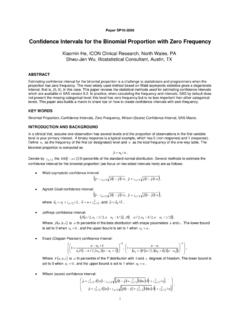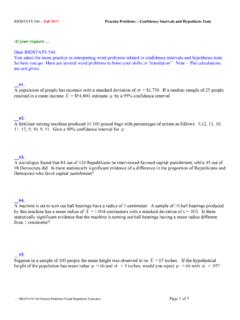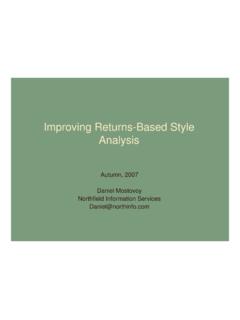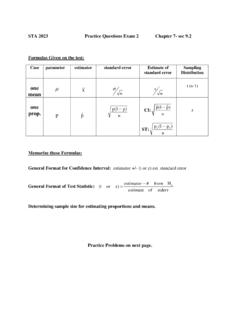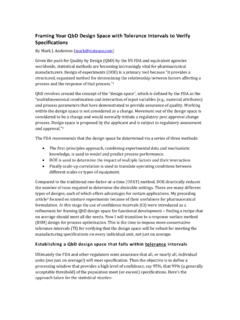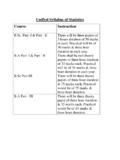Transcription of Sampling Distribution of the Mean - Ilvento
1 Sampling Distribution of the MeanDr Tom IlventoDepartment of Food and Resource EconomicsOverview This is one of the most important topics in the course Sampling distributions are key to the logic of inference It is based on the notion of taking many, many And making an estimate from each sample In reality we only take one sample, but we will think of it as one of many possible And our estimate as one of many estimates that follow a certain Do you intend to vote for in the 2008 Presidential Election? All polls were taken in mid-September, 2008 We expect variability from sample to sample we call it Sampling error340%41%42%43%44%45%46%47%48%49%50%C BS/NYTARGrpPewReutersWho Do You Intend to Vote For?ObamaMcCainNow we start toward inference Remember we noted that A parameter is a numerical descriptive measure of the population We use Greek terms to represent it It is hardly ever known A sample statistic is a numerical descriptive measure from a sample Based on the observations in the sample We want the sample to be derived from a random process4 Help me do a little experiment Toss a die three times Each time we toss the die three times we note and record the faces Then calculate mean and median We can do this a number of times5 Results of some trials of the experiment6 SampleResultMeanMedian15 4 4 5 1 4 3 Priori we have the following expectation and variance E(x) = = 1(.)
2 1667) + 2(.1667) +3(.1667) + 4(.1667) + 5(.1667) + 6(.1667) E(x) = = E(x- )2 = !2 = ( )2(.1667) + ( )2(.1667) + (3- )2(.1667) + ( )2(.1667) + ( )2(.1667) + ( )2(.1667) E(x- )2 = !2 = ! = (X) used the following as a sample There are 6*6*6 = 216 different combinations of outcomes of rolling three die If I take the mean of each possible outcome And take the summary statistics (including the mean of the means) I get the following table (from Excel)8 Sampling Distribution of the Sample Mean for rolling 3 die Notice the mean of the sample means is , the population value But the standard deviation is something less than the we expected But try this - divide by the SQRT(3) - the sample size (n) This value is .986 - which is essentially the standard deviation of this variable And the Distribution looks very much like a normal distribution9 Comparing the Mean vs the Median for this Sampling Distribution I also calculated the statistics for the median of each sample If I compare the mean to the median.
3 The standard deviation for the mean is smaller The mean as a measure of this Sampling Distribution has minimum Distribution Sample statistics are random variables - they vary from sample to sample We can look at their probability Distribution based on repeating the Sampling experiment many times - we will get different sample statistics each time If we do repeat the experiment many times results in a Sampling Distribution The Sampling Distribution of a sample statistic calculated from many samples of n measurements results in the probability Distribution of the do we want from an estimator of the population parameter? If the sample statistic is a good estimator of We would expect the values of the sample means to cluster around We wouldn t want to cluster to be at a point above or below (not be biased) And we might say our estimator is good if the cluster of the sample means around is tighter than the Sampling Distribution of some other possible estimator (minimum variance)
4 12 Think our our estimator in terms of a Bulls-Eye Target We want our estimates to center around the true value A tighter fit around the target Minimum Variance better and preferred A biased estimator may have a tight fit, but consistently misses the target in a discernible way This is the kind of pattern we would like to see a tight fit around the population parameter13I did a simulation to help construct a Sampling Distribution for the mean We took 100 random samples of size n = 50 From a population of X ~ N (75, 10) The mean of the means should equal the population parameter, = 75. The standard deviation of this new Distribution should be related to !, but we might expect it to be smaller14nx!!== 10/(50).5 = standard deviation of this Sampling Distribution is called a standard errorResults of the Experiment based on repeated samples from a population with a mean of 75 and a standard deviation of 10 100 different random samples The exercise resulted in a Mean of , very close to Std Dev = This is very close to the expected Std Error of 10/(50).
5 5 = DevStd Err Meanupper 95% Meanlower 95% MeanNSum WgtSumVarianceSkewnessKurtosisCVN 786 78 775569 77000334 76556899 76001112334 755555677888889 7500223333344444 7456677788889 740001111123333 735556778899 7301112234 72778 7214 Count14669131411131083272|1 represents and LeafSampling Distribution of the Mean, Normal Distribution , 75, 10 Sampling theory and Sampling distributions help make inferences to a population Let's use the example of the mean to set up our discussion of a Sampling Distribution . Suppose we are looking at a variable, , average purchases of customers at an Internet sales company. We think of the population (let's use the Population of adult customers of our Internet company in 2008). We believe there is an average purchases of this population, designated as . We want to take a random sample to estimate .16 Inferences from a sample Our sample estimator of the population mean is: The variance of our sample estimate is given as: where n is equal to the sample size s2 is a unbiased estimator of population variance !
6 217nxx!=1)(22!!="nXxsInferences from a sample The standard deviation represents the average deviation around the sample mean. But we only took one sample out of an infinite number of possible samples . A reasonable question would be what is the deviation around our estimator ( , the sample mean). That is, what if we took a whole bunch of samples , and recorded the mean of each sample what it would look like?18 Inferences from a sample If we could take an infinite number of samples , each sample would most likely yield a different sample mean. Yet, each one would be expressed as a reasonable estimate of the true population mean. So, if we were able to take repeated samples , each of sample size n, what would be the standard deviation of the sample estimates? Sampling theory specifies the variance of the Sampling Distribution of a mean as:19 The square root is called the Standard Error of the meanInferences from a sample The standard error of the mean is the standard deviation of a Sampling Distribution of means from samples taken from a population with parameters equal to and !
7 2. If we don't know !2 we use the unbiased sample estimate of s2 to estimate the Sampling variance of the is the strategy We use the theoretical Sampling Distribution to make inferences from our sample to the population. The Sampling Distribution of an estimator is based on repeated samples of size n. We may never actually take repeated samples But we could think of this happening And we think of our observed sample as one of many possible samples , of size n, we could have drawn from the population21 This is the strategy We expect that the standard deviation of Sampling Distribution of the estimator (in this case the mean) will be smaller than that of the population or the samples themselves. We expect some variability across samples , but not as much as we would find in the population. Thus the Sampling error is smaller than the standard deviation for the Standard Error The Standard Error depends upon: The size of n (as n gets larger the SE gets smaller) The variance of the population variable itself.
8 We can think of this as homogeneity. The larger the sample size, and the more homogeneous the population, the smaller the standard error is for our estimator. 23 Properties of the Sampling Distribution for the Mean If a random sample of size n is drawn from a population with mean and standard deviation !, then: The Sampling Distribution of the means has a mean equal to the population mean . And the Sampling Distribution of the mean has a standard deviation equal to the standard deviation of the population standard deviation !, divided by the square root of the sample size n. And if we don t know !, we use the sample standard deviation, use two theorems to help us make inferences In the case of the mean, we use two theorems concerning the normal Distribution that help us make inferences One depends upon the variable being normally distributed The other does not - Central Limit Theorem25 Summary We are on our journey toward inference A key part of this journey is understanding a Sampling Distribution The Sampling Distribution is the theoretical Distribution of making an estimate of a parameter from many, many samples The Sampling Distribution of the mean (and proportion), will follow a normal Distribution (under certain circumstances) Knowing the form of the Sampling Distribution will help in inference through confidence intervals and hypothesis tests26


